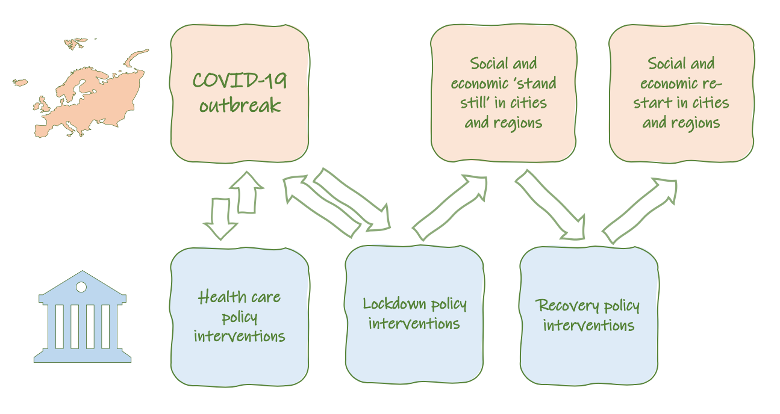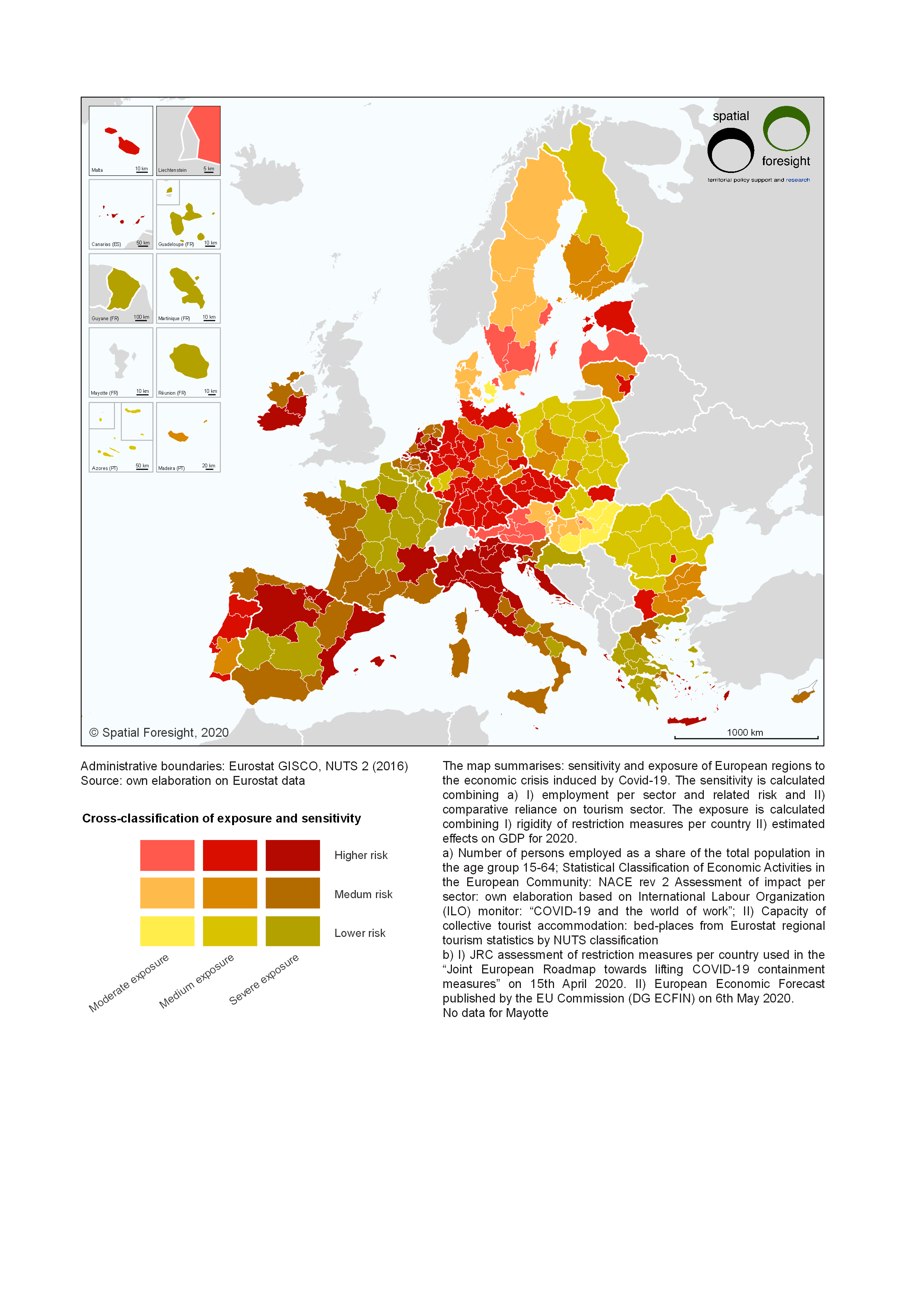
KREMER July 2020
The EU Recovery Plan
A budget without a vision risks to increase inequalities
Guest contribution by Christian Lüer and Kai Böhme
The historic EU budget deal risks widening the economic and social gap in Europe. The EU needs a common vision more urgently than the trillion-euro package.
EU leaders have made history by agreeing on a recovery plan to combat the effects of the corona pandemic. This can already be said today, although the European Parliament's approval is still pending and resistance on certain points is to be expected. Joint debts and the financial volume of the 1.8 trillion-euro package consisting of the recovery plan and the next multi-annual financial framework alone represent a milestone in the process of European integration. Ultimately, however, its success will be measured by its actual impact. The main question is whether and how quickly European economies will get back on their feet. Behind this, there is also the question of the spatial dimension. Which cities and regions will recover quickly, and which will continue to struggle with recovery for many years?
With the financial crisis of 2008/2009, economic and social convergence came to a halt in Europe. Can the recovery plan put Europe back on the pathway of convergence and really counteract the growing inequalities both between and within EU Member States? A closer look raises doubts despite the historical dimension of the overall package.
The corona pandemic and the policy responses to it differ in their regional impact. This concerns the infection rates, the lockdown measures and probably also the economic recovery process (see figure). The consequences of the pandemic will also differ within and not only between nation states (see map). However, the issue of regional differences appears to be absent in the EU summit poker game. The negotiations have once again shown that the EU is regarded being a national zero-sum game by many national governments. With their compromise, the heads of state and government have demonstrated their ability to act and find agreement. However, the ideas on the future of the EU obviously diverge widely. A shared vision for Europe is not discernible. The lack of such a vision has hampered joint action and finding a more advanced compromise. Moreover, it raises the question for what purpose and on what the extra billions should be spent. Various questions are on the table.
Is financing really the core problem?
The pandemic has revealed the political rifts in Europe. Instead of solidarity, the focus was on unilateral action, culminating in the hoarding of medical supplies and the return to border controls in the Schengen area. Furthermore, the political rifts became apparent in the heated disputes during the recent summit negotiations although recent experience from the pandemic should have made it clear for everybody that no country can handle the upcoming challenges on its own. Consequently, developing better mechanisms for coordination and cooperation between Member States is one of the key challenges. Structural adjustments in the EU's institutional set-up and in intergovernmental cooperation are urgently needed. In order to overcome the obvious weaknesses, Europe needs first and foremost willingness to reform and further develop the EU. In order to counteract European disintegration effectively, strong public administrations and a reduction of inequalities are important core elements.
Does the money arrive where it is needed most urgently?
The provisions known so far for the instruments of the recovery plan put national governments in the driver’s seat. They decide where and for which purpose money is spent. The different needs and recovery potential of regions and cities, on the other hand, seem to be hardly taken into account. They still play a crucial role in EU regional policy. However, this could change if more and more decisions are taken in the capitals. If the implementation of the recovery plan encourages the nationalisation and centralisation of policy making and implementation, it is precisely the needs of weak regions that could be undermined. This would further increase inequalities in Europe.
Will the money arrive in due time?
The European Commission estimates that only about 30 percent of the money made available by the recovery plan will be paid out in the next 2.5 years, i.e. by the end of 2022. Although the funds can certainly cushion long-term losses over the next few years, the support is likely to arrive very late for the most severely affected companies, social groups and public institutions. For many, it might even be too late, as not all regions in Europe have the means to bridge the time until the money arrives. Also, from a time perspective, there is a risk that already existing tensions and imbalances will intensify.
What is the money ultimately used for?
Political leaders assured that the money is used to promote a sustainable and digital European society. However, there is also a risk that national, regional and local actors will spend the money to satisfy rather short-term needs and particular interests than to effectively promote urgently needed structural transformation. First analyses of the new, already decided flexibility in the use of EU funds suggest that quite a few national and regional players will go for easy short-term investments rather than using the resources for strategic long-term investments. The same is likely to be true for the money from the recovery plan. However, inequality can only be tackled effectively if future prospects are developed especially in structurally weak regions.
Do local and regional administrations have the necessary resources?
The corona pandemic has posed serious challenges to the administrative apparatus in many Member States, regions and cities. The administrations must now promptly build up the necessary capacities to apply for additional funding and spend it wisely. Existing programmes must be adapted, new programmes must be drafted and implemented. Already in the past, administrations with reduced capacities have not fully spent their EU funds. In structurally weak regions, for example, administrations regularly fail to develop future-oriented projects, provide their co-financing and overcome bureaucratic obstacles. Better-positioned regions, on the other hand, are much more effective in applying for support and using it strategically. This, too, can further intensify inequalities between and within Member States.
Chance for a fresh start
In order to turn the current crisis into an opportunity for real change, we need a debate on how we envisage the EU after the corona pandemic. Do we want a different Europe, or do we want to return to the pre-corona era? Four aspects are particularly important in this respect.
- In order to effectively combat the effects of the corona pandemic, it is necessary to target financial resources towards the following main objectives. Support should focus on those cities and regions where particularly affected economic sectors play a major role. Particular attention should also be paid to cities and regions undergoing profound structural transformation. Finally, social aspects must be given priority. The weakest in society are particularly affected by the corona pandemic. Regions and cities with high shares of elderly people, migrants or people with low incomes are thus facing particular challenges.
- European integration can only succeed if the diversity of European cities and regions with their different potentials and challenges is taken into account. There is no one-size-fits-all solution that works for all cities and regions. It is essential that regional and local representatives are involved in planning, developing and implementing recovery programmes right from the start. Without a clear commitment to multi-level governance, the recovery process will produce few winners and many losers. There is a high probability that structurally weaker regions will be among the losers. This would further increase regional disparities in Europe as a whole.
- There is a lack of a shared vision for Europe after the corona pandemic. Without such a vision or strategy, there is a risk that the financial support will not be sufficiently targeted. As a first immediate response, the generous and largely uncontrolled distribution of tax money was absolutely necessary. However, if the recovery plan is to point the way towards a new future, a shared idea of what Europe should look like in that future is needed. The various instruments and programmes can then be geared to this idea. Only then, the recovery plan will deliver European added value.
- Finally, we need a debate on the future of Europe. However, this debate is not primarily a debate to be conducted by the Heads of State or Government. It must be broadly anchored in European society and at various scales – at neighbourhood level and in small towns, in the metropolises and in rural areas. It must also take account of interdependencies between places, i.a., at cross-border and transnational level. Only this way, it can be ensured that, after the corona pandemic, Europe offers prospects for an attractive future for all citizens in all cities and regions.
An earlier version of this text has been published in the German Handelsblatt.
About the authors
Christian Lüer and Kai Böhme work at Spatial Foresight, a private consultancy and independent think tank in the area of European territorial policies and research.
Interplay of COVID-19 and policy responses

